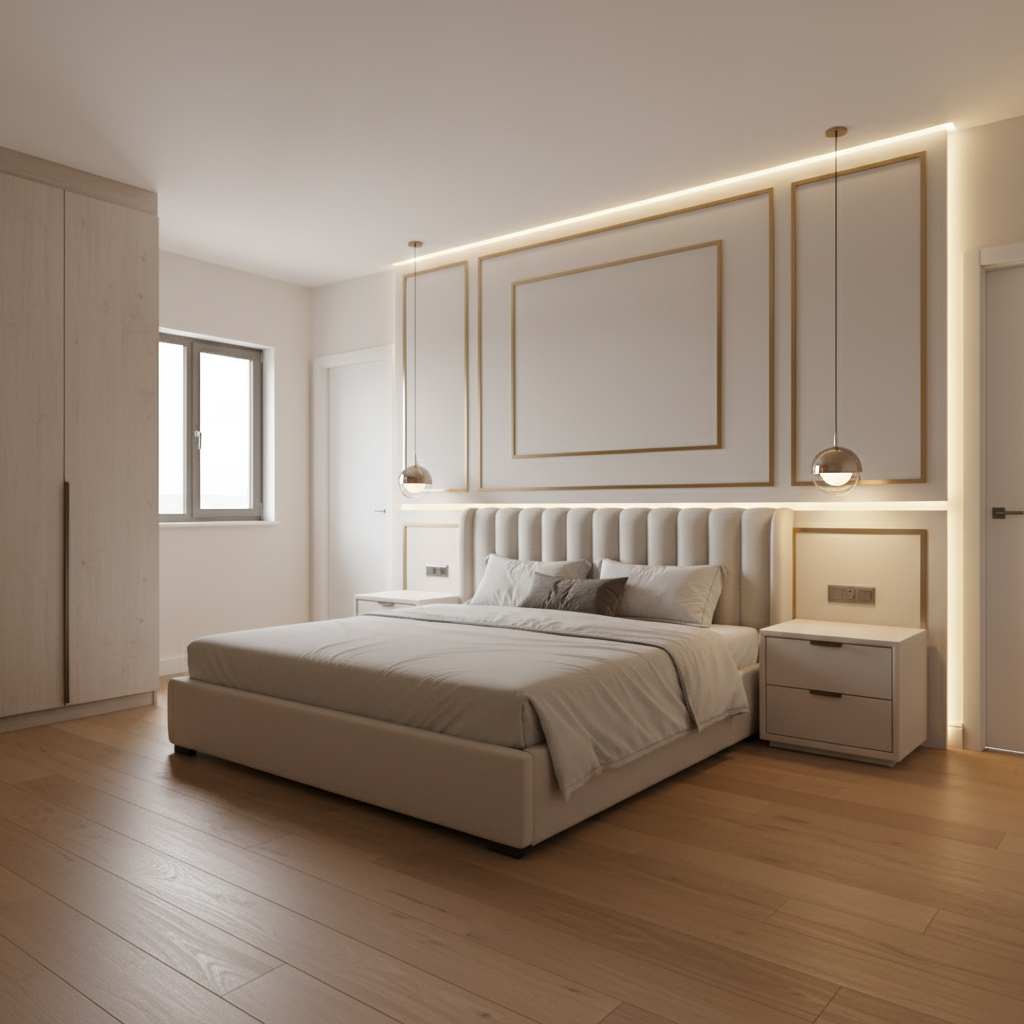Serene Neutral Bedroom Interior Design With Layered Textures
Design Analysis
What Lasts
The solid platform construction and simple frame geometry are durable over time; a well-made frame resists sagging and keeps alignment. The vertical channel headboard is a classic detail that ages gracefully and conceals wear better than plain flat upholstery because seams hide small stains and abrasion.
What to Watch Out For
Fabric upholstery shows oils and stains from skin and hair products; light neutrals reveal discoloration faster. Low-profile frames can transfer motion if the internal slats or supports are insufficient. Upholstery foam may compress over years, and seams at channels can separate if poorly stitched.
Care Tip
Vacuum fabric weekly with a soft brush; blot spills immediately with a damp cloth and mild detergent. Rotate mattress and pads per manufacturer guidance to reduce uneven wear. For stubborn stains, use fabric cleaner recommended for the upholstery type and test out of sight first. Tighten frame bolts annually.
What Lasts
Good-quality mattress cores (innerspring, pocketed coils, or high-density foam) can last 7–10 years with regular rotation. Natural-fiber linens and cotton blends breathe well and soften with each wash, often improving feel over time.
What to Watch Out For
Mattress dips and sagging reduce support; thin or non-breathable mattress protectors trap moisture and accelerate foam breakdown. Light-colored bedding stains more easily; heavy laundering can fade colors if detergents are harsh.
Care Tip
Use a breathable mattress protector, rotate the mattress every 3 months, and air bedding regularly. Wash duvet covers and sheets weekly or biweekly on gentle cycles; use color-safe detergents and line-dry when possible to extend fabric life.
What Lasts
Solid drawer construction with dovetail joints and good-quality slides endures years of use. Simple shapes and neutral finishes stay visually relevant across style changes.
What to Watch Out For
Particleboard or low-grade MDF tops can swell with spills; painted finishes can chip at edges. Drawer hardware and slides wear with heavy use and may need replacement after several years.
Care Tip
Keep liquids on coasters and wipe spills immediately. Tighten drawer runners occasionally and clean slides with a dry cloth; apply a silicone lubricant if sticking occurs. Avoid heavy standing weight on top surfaces.
What Lasts
Metal fixtures and simple suspension hardware have long lifespans. Bulbs (especially LEDs) last many years and produce little heat, protecting surrounding finishes.
What to Watch Out For
Suspension points and cord wear over time—if not correctly anchored, vibrations can loosen fittings. Metal finishes can tarnish or scratch, and integrated dimmers or switches may fail before fixtures do.
Care Tip
Dust regularly with a soft microfiber cloth. Check canopy anchors and tightening screws once a year. Use LED bulbs to reduce heat and replace bulbs before they flicker to protect drivers and wiring.
What Lasts
Painted mouldings and metal trim are visually durable; the architectural detail resists trends and adds resale value. Quality LED strips provide long life with low energy use.
What to Watch Out For
Poorly installed LEDs may have uneven light or fail prematurely if overheated. Gaps at moulding seams can develop as the building settles. Metallic trim can chip or show fingerprints on high-contact edges.
Care Tip
Keep LEDs on a dimmer or controller to lengthen lifespan. Caulk and paint seams with flexible acrylic caulk to prevent cracks. Dust moulding and metal trim gently; polish metal sparingly with a soft cloth.
What Lasts
Continuous built-in casework resists movement and offers robust storage for many years. Timber veneers or solid wood face panels can be sanded or refinished if scratched.
What to Watch Out For
Hinges and sliding hardware take the most wear; poor ventilation inside can lead to stale odors or mold in humid climates. Lighter finishes show dirt and scuffs near handles.
Care Tip
Keep interior ventilated; use breathable storage boxes and cedar blocks to manage moisture and pests. Service hinges and track rollers yearly and clean surfaces with a wood-appropriate cleaner to protect finish.
What Lasts
Solid hardwood floors, when well-finished, can last decades and be refinished multiple times to renew appearance. Wide planks show fewer seams and feel more timeless.
What to Watch Out For
Scratches from furniture, moisture damage near windows or doors, and finish wear in high-traffic zones can occur. Humidity swings may cause boards to gap or cup in extreme conditions.
Care Tip
Use felt pads under furniture legs and a soft broom or vacuum for regular cleaning. Wipe spills promptly; maintain indoor humidity between 40–60%. Recoat or refinish finish every few years depending on wear.
What Lasts
Quality frames (vinyl, aluminum, or wood-clad) and double-glazed glass panels last many years and improve thermal comfort. Properly sealed windows maintain performance.
What to Watch Out For
Sealant and weatherstripping degrade over time, allowing drafts or moisture ingress. Condensation can lead to mold on sills if ventilation is poor.
Care Tip
Inspect and replace seals periodically; clean tracks and keep drainage holes clear. Wipe frames and glass with appropriate cleaners and air the room to reduce condensation after showering or cooking.
What Lasts
Solid-core doors and well-painted trim resist dents and sound transmission better than hollow alternatives. Classic trim profiles remain stylistically flexible.
What to Watch Out For
Paint chips and scuffing occur at handle height and baseboards near foot traffic. Hinges and latches can sag over time leading to binding doors.
Care Tip
Touch up paint as needed and clean trim with a mild soap solution. Tighten hinge screws annually and use door stoppers to protect walls and trim from repeated impact.
AI Design Assistant Available
Get expert design advice! Mention @DesignerAI in your comments or replies to get personalized design recommendations based on this design.
💡 Examples:
- • "@DesignerAI what colors would work best for a smaller space?"
- • "@DesignerAI how much would this cost to implement?"
- • "@DesignerAI suggest budget-friendly alternatives"
Comments
(0)Please log in to add comments and get AI responses
No comments yet. Be the first to comment!
Loading related designs...
